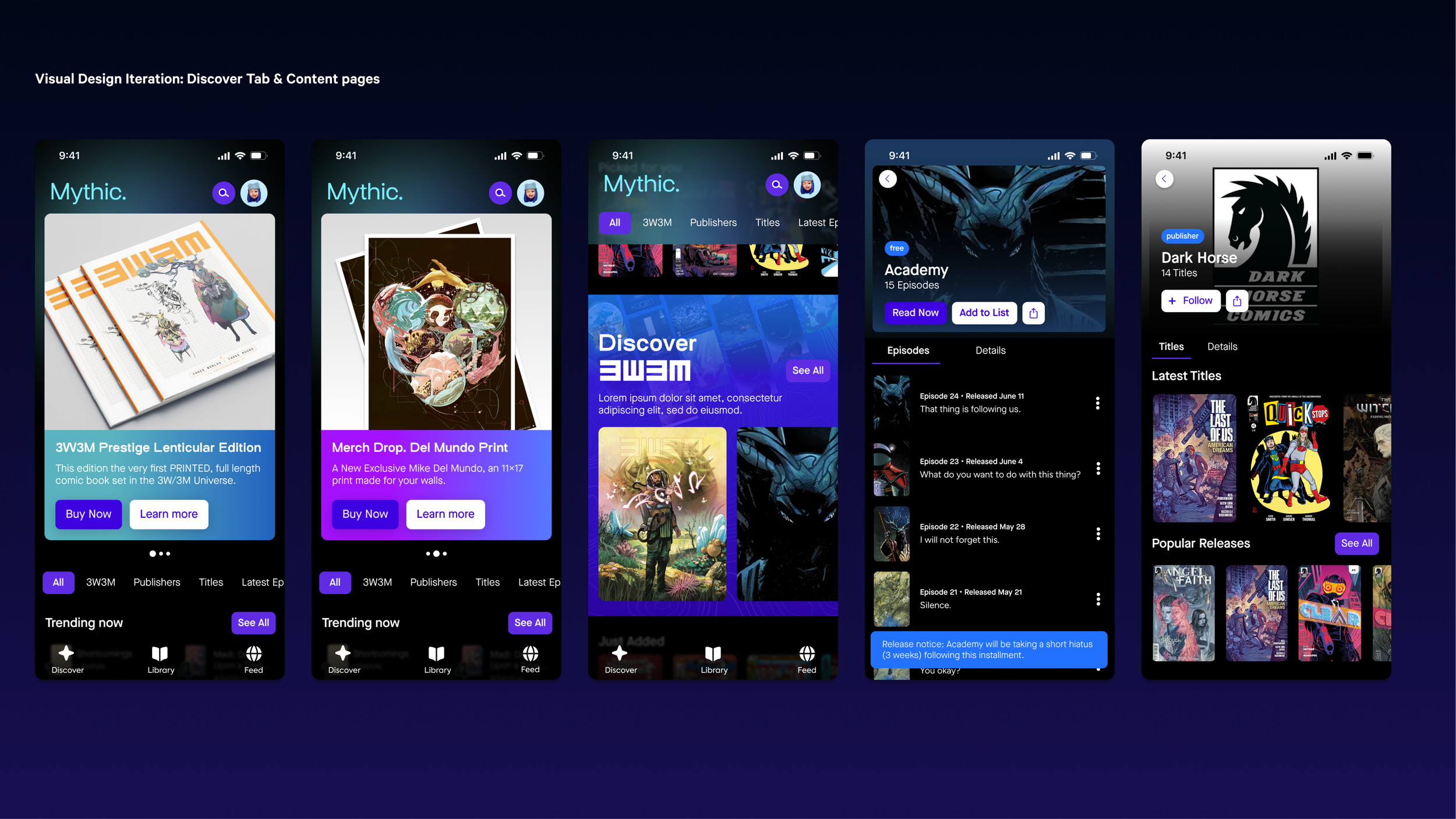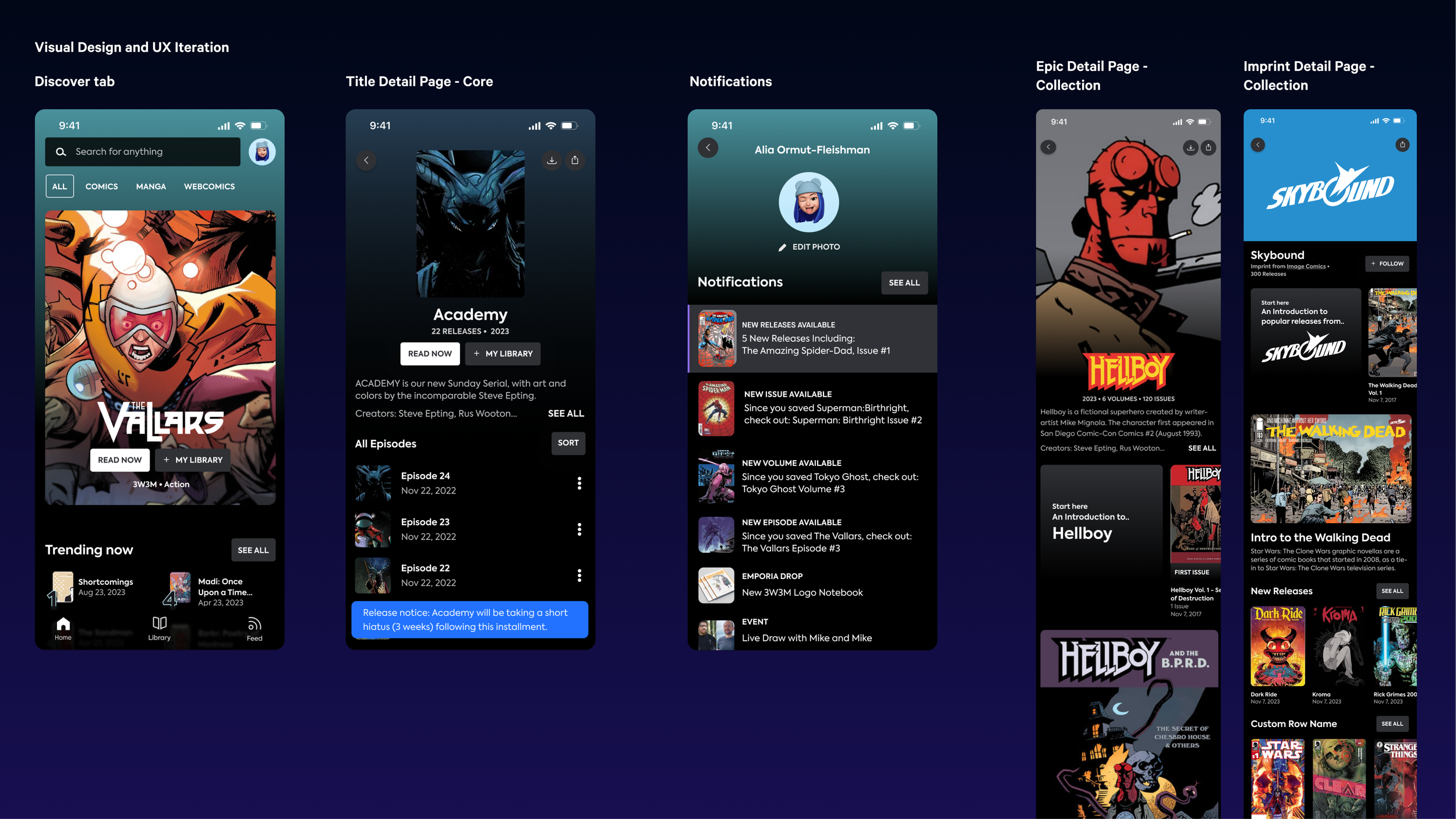Mythic - iOS App design
For the comics startup 3W3M, I designed their first iOS app, Mythic — a marketplace for comics, first for their existing Substack community.
I led the product from 0–1, creating brand components, color palettes, typography, UI elements, and interactions. The app launched first to a beta group of Substack users before releasing publicly on the App Store in 2024.

Project Details
Project Goals:
At Mythic, I worked with comic writers and illustrators with experience from Marvel who were working on spinning up their first app to showcase their multi-universe comics 3W3M, as well as create a marketplace for comic apps where their built in user base of comic fans could read, purchase and save their favorite titles. Along with the app’s design, for this project I was tasked with defining the app’s visual look and feel, and led product strategy alongside the company’s CEO and CTO.
Role:
Lead Designer, UX, Visual Design, Product Strategy
Process:
I initially did market research and hosted a brand workshop with our start-up team to define the building blocks of the Mythic / 3W3M visual brand, including brand definition, picking color palettes and typography to allow me to have the building blocks to begin design. Concurrently, I met with the CTO, CEO and team to define the app’s goals, and created a design schedule to align with our engineering schedule ahead of release. I next created app user flows to frame scope, app content and app structure informed by market research I completed in this role, as well as input from the team.
Because I was defining product strategy alongside our CEO, I also set up a Notion workspace for design and created Product Requirement Docs for each of our main pages to make sure our team was on the same page regarding feature goals, scope and release timelines. Additionally, I aligned with out engineers and CTO on what our approach to using a CMS/content hosting should be. I worked through the app design feature in a staggered schedule working backwards from the team’s intended release date to a smaller release to the company’s Substack members, and created design ceremonies to review with our team as I iterated on feature designs.
Metrics considered:
DAU, MAU, Session Intervals, Session Length
Process
Definition:
In order to begin designing the UX for the app and the overall IA structure, I created app user flows and met with our start-up team to ensure I was covering all of the content needs for the app. The app’s structure then relied on market research and comparable experiences to help me define it. I also researched content app metrics at this time to help our team plan for which metrics we would track in our app to test success upon release in the app and play stores.
Once I completed market research for the app, met with our co-founders and CTO and created a user flow mapping out the app’s main pages, the app’s structure focused on a structure of 3 main pages: a Discover tab to help users discover new 3w3m content and comic content, a Feed tab to interact with comic artists and a Library tab for users to save their content and create their ‘comic collection’. Once we had this structure, I was able to create a feature design schedule to map with engineering’s timeline. I first designed the app’s Discover feed, knowing that I would need to incorporate content pages in this process as well, and that there would be complexity in designing for different releases and different types of comic publishers.
After spending the bulk of the design schedule designing our Discover tab and content pages, I designed our library tab, feed and notification experiences.
As I worked through designing each feature, I began with low-fidelity user flows and wireframes, and framed design decisions with market research before working into higher fidelity visual mock designs and prototypes to share with the team. I then reviewed each feature iteration with our CEO, CTO and engineers before finalizing our feature designs.
Iteration
IA Structures and UX Complexity:
As I designed the content pages that lived off of our Discover tab, I scoped with our CEO that we had to design content pages for multiple types of pieces of content. Content pages for the app were defined to be designed at this stage for differing types of single titles of comics, which included: Title Releases for US and European comics which could contain episodes, issues or other titles which would singularly lead to a reading view and Manga comics which could include Volumes or related titles which could lead to related page collections before a customer could read the issue.
Additionally, I defined with our CEO at this time, that the team wanted to include different content collection pages for Publishers and more general comic collections. These additions were necessary at the time as our start-ups goal was to be a competitor to other popular comic marketplace apps like Webtoon and GlobalComix, so we had to reach parity for title hosting in order to pitch to publishers.
Due to the complexities needed in our title IA structure, I stepped back from creating UX and visual designs at this time and went back to creating IA flows. In particular, at this stage we were deciding between a flat tab structure and creating title detail pages for related series which were a collecting in themselves. In addition to creating IA structures to choose between to visualize the content difference, I also documented our content decisions in Notion so that there would be a source of truth as the project continued.
After creating differing IA structures, I then met with our CEO and CTO to ensure the structure aligned from a content perspective of comic needs, as well as aligning with our CTO and engineers to make sure we were aligned in how we were thinking about app structure.
Once we were aligned on final IA structures, I returned to designing out our UX and visual designs for our app.
Visual Design Iteration
As I designed the main UX and components for Mythic’s app: the Discover feed, content feed and Library, I was also iterating on visual design. Many of the visual design decisions were made alongside completing the UX and component design for the app’s Discover feed since this was the most complex piece of the app’s design, and because of this complexity I had also scheduled this design to be completed first in our schedule to lay the foundation for the rest of the app. To complete the visual design for the app, I relied on the color palette and typography pairing I designed after hosting a brand workshop with our start up team to get the team’s buy in for our direction and understand what the brand was trying to achieve. The result of this workshop was a look and feel that was used a dark background to let the comic content shine and was informed by 3W3M’s illustrations, which were based in a space universe so I integrated brighter pops of purple and blues against a dark background to illustrate the space-like feeling.
In this process I using the initial color palette and typography styles to determine visual styles, explored button color palettes according to semantic meaning: Primary. Secondary, Marketing Interactive Colors. Our visual design and brand direction was influenced by consumer dark mode apps like Spotify, ‘web3’ style apps, as the team was interested in including web3 content in a later app release and informed by a brand mood board I created of apps, websites and illustration with a sci-fi feel, incorporating IP illustration style of 3W3M.
As I designed the discover tab and our main tabs, I made sure to include time in our schedule to iterate on visual design and reviewed against the light brand guidelines I created for the team to evaluate the designs.
Final Designs
After iterating on visual designs with the team, and receiving initial feedback from investors, designs were completed for Mythic’s first iOS app. The app’s features include: a discover feed to discover and save new content, a feed for Mythic and it’s artists to get in touch with their community, a comic reader with multiple reading modes and a content library to create a user’s comic book collection. Throughout the app’s design, our goal was to create an intuitive way for customers to discover and consume comics digitally, without losing the magic of consumer the medium through it’s original form. This app’s design was a great exercise for me to think through end to end UX and visual design throughout an app and executing quickly - we finished the app’s concept, direction and full design in eight months, and have since received positive reviews from users.
The app design was released first to Substack members, and subsequently had a release in the app store for iOS.







